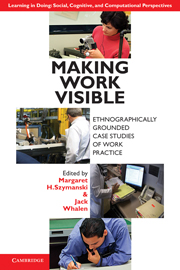Book contents
- Frontmatter
- Contents
- List of Figures and Excerpts
- List of Tables
- List of Contributors
- Series Foreword
- Foreword by John Seely Brown
- Acknowledgments
- Introduction
- Part I Work Practice Study in Historical Context
- Part II Applying Work Practice Methods
- 3 Uncovering the Unremarkable
- 4 Work Practices to Understand the Implications of Nascent Technology
- 5 Tokyo to Go
- Part III Practices around Documents
- Part IV The Customer Front
- Part V Learning and Knowledge Sharing
- Part VI Competency Transfer
- References
- Index
- LEARNING IN DOING: SOCIAL, COGNITIVE AND COMPUTATIONAL PERSPECTIVES
3 - Uncovering the Unremarkable
Published online by Cambridge University Press: 05 August 2012
- Frontmatter
- Contents
- List of Figures and Excerpts
- List of Tables
- List of Contributors
- Series Foreword
- Foreword by John Seely Brown
- Acknowledgments
- Introduction
- Part I Work Practice Study in Historical Context
- Part II Applying Work Practice Methods
- 3 Uncovering the Unremarkable
- 4 Work Practices to Understand the Implications of Nascent Technology
- 5 Tokyo to Go
- Part III Practices around Documents
- Part IV The Customer Front
- Part V Learning and Knowledge Sharing
- Part VI Competency Transfer
- References
- Index
- LEARNING IN DOING: SOCIAL, COGNITIVE AND COMPUTATIONAL PERSPECTIVES
Summary
At the beginning of this decade, Xerox Research Centre Europe's Cambridge laboratory was building on the already successful work practice research undertaken in its Studies of Technology and Organizational Work group through a new research endeavor titled Emerging Office Environments. Whilst a part of this continued the tradition of looking at large-scale organizational phenomena, another part of it was tailored to a brief but concentrated Xerox interest in Small Office–Home Office environments. This interest led not only to studies of small enterprises but also of teleworking and domestic settings. There were a number of outcomes from these studies across many research themes, notably with regard to paper-digital practices. However, one of the most influential ideas to come out of these studies was the concept of “unremarkable computing.” Unremarkable computing was, in part, a response to one of the principal tropes in ubiquitous computing where there is a notion of making computing disappear into the environment or become invisible. Unremarkable computing is a foundational respecification of what that might mean and focuses upon how things might be taken to be unremarkable in practice. However, the notion of uncovering what is unremarkable in practice has a wider application. At the point of pedagogy and analytic rigor it also has considerable purchase for arriving at an understanding of what is “in plain view.”
- Type
- Chapter
- Information
- Making Work VisibleEthnographically Grounded Case Studies of Work Practice, pp. 53 - 73Publisher: Cambridge University PressPrint publication year: 2011
- 3
- Cited by



